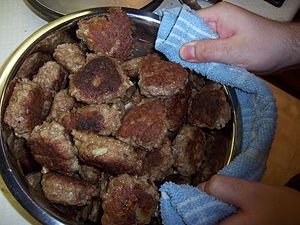Frikadelle: Difference between revisions
mNo edit summary |
mNo edit summary |
||
| Line 6: | Line 6: | ||
| caption = A freshly made batch of frikadeller |
| caption = A freshly made batch of frikadeller |
||
| alternate_name = |
| alternate_name = |
||
| country = Denmark |
| country = Germany, Denmark |
||
| region = |
| region = |
||
| creator = |
| creator = |
||
Revision as of 12:17, 11 March 2011
Frikadeller are flat, pan-fried dumplings of minced meat, often likened to the Danish version of meatballs. They are a popular dish in Germany, Denmark, Poland and the Netherlands. In Sweden, poached quenelles are called frikadeller and are usually served in soup.
Many variations of frikadeller exist but traditionally they are made of minced pork, veal, or beef; chopped onions; eggs; milk (or water); bread crumbs (or oatmeal or flour); salt; and pepper; then formed into balls and flattened somewhat. They are then pan-fried in pork fat, or more commonly in modern times in butter, margarine or even vegetable oil.
As a main dish they are most often served with boiled white potatoes and gravy (brun sovs) accompanied by pickled beetroot or cooked red cabbage. Alternatively they can be served with creamed, white cabbage.
Frikadeller are also a popular choice on the Danish lunch buffet, eaten on rugbrød with red cabbage or pickle slices. They can also be served cold, sliced thinly as a base for open face sandwiches on rye bread.
The combination of frikadeller and a cold potato salad is very popular at picnics or potluck dinners, due to the ease of transporting either component after cooking.
A common variant of frikadeller are fish frikadeller, made from a similar recipe with minced fish instead of pork or chicken.
Lacto-ovo vegetarians can also make vegetarfrikadeller with grated parsnip, beetroot and carrots as fake meat.[1] Feta cheese can be added to the frikadeller to make them 'greek' frikadeller.

